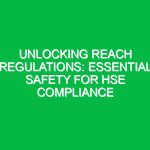Introduction
The REACH Regulations, which stand for Registration, Evaluation, Authorisation, and Restriction of Chemicals, form a cornerstone of Chemical Safety in the European Union. Established to ensure that chemical substances are manufactured and used safely, REACH regulations have significant implications for health, safety, and the Environment (HSE). These regulations require companies to gather information on the properties and Hazards of substances they produce or import, thus enabling informed decision-making regarding chemical Safety.
In the context of HSE compliance, understanding and adhering to REACH regulations is paramount. Not only do these regulations protect human health and the environment, but they also foster a culture of responsibility among businesses that handle chemicals. By implementing REACH effectively, organizations can mitigate risks, enhance Workplace Safety, and contribute to sustainable environmental practices.
This article will delve into the essential aspects of REACH regulations, their relevance to HSE, and the Best Practices for compliance. We will explore the key components of REACH, discuss real-world implications, and provide actionable insights for organizations striving to comply with these regulations.
Key Aspects of REACH Regulations
Understanding REACH Structure
REACH is structured around four main processes:
- Registration: Manufacturers and importers must register substances with the European Chemicals Agency (ECHA) before they can be placed on the market. This registration requires detailed information about the chemical’s properties, uses, and Safety Measures.
- Evaluation: The ECHA evaluates the information submitted during registration to assess the risks posed by chemicals. This process ensures that substances meet Safety Standards and do not pose a threat to human health or the environment.
- Authorisation: Certain substances of very high concern (SVHCs) require authorisation for specific uses. Companies must demonstrate that risks can be adequately controlled or that the Benefits outweigh the risks.
- Restriction: REACH provides mechanisms to restrict the manufacturing, marketing, or use of specific hazardous substances to protect human health and the environment.
Importance of Safety Data Sheets (SDS)
One of the critical components of REACH compliance is the Safety Data Sheet (SDS). An SDS provides detailed information about a chemical’s properties, hazards, handling, and safety Precautions. Companies are required to provide SDSs to downstream users and ensure that they are updated regularly to reflect any changes in regulations or safety standards.
The effective use of SDS in HSE compliance cannot be overstated. It serves as a vital tool for Training employees about potential Hazards and safe handling practices. By integrating SDS into Workplace Safety programs, organizations can significantly reduce the risk of chemical-related incidents.
Identifying and Assessing Risks
A fundamental aspect of REACH regulations is the requirement for companies to identify and assess risks associated with the chemicals they handle. This involves conducting a thorough risk assessment to determine potential exposure scenarios, hazard classifications, and risk management measures.
For instance, a hypothetical case could involve a manufacturing facility that uses a solvent in its production processes. By conducting a risk assessment, the facility can identify potential health risks to employees, such as inhalation or skin contact. With this information, the company can implement appropriate Safety Measures, such as improved ventilation systems, personal protective equipment (PPE), and training programs focused on safe chemical handling.
The Benefits of Compliance with REACH Regulations
Enhanced Employee Safety
One of the most significant benefits of adhering to REACH regulations is the enhancement of employee safety. By thoroughly evaluating chemical substances and implementing necessary safety measures, companies can create safer working environments. A study conducted by a European safety organization found that businesses that fully comply with REACH report significantly fewer workplace accidents related to chemical exposure.
Environmental Protection
REACH regulations contribute to environmental protection by restricting hazardous chemicals and promoting safer alternatives. By ensuring that chemicals are evaluated for their environmental impact, REACH helps reduce pollution and the risk of chemical accidents. Companies that proactively adhere to REACH can also improve their corporate image, appealing to environmentally conscious consumers and stakeholders.
Legal Compliance and Avoidance of Penalties
Non-compliance with REACH regulations can result in severe penalties, including fines and sanctions. Businesses that prioritize compliance not only avoid these risks but also cultivate a reputation for responsibility and adherence to legal standards. This proactive approach can lead to better relationships with regulatory bodies and increased trust from clients and customers.
Market Advantage
In today’s market, consumers increasingly demand transparency regarding the safety and environmental impact of products. Companies that demonstrate compliance with REACH regulations can leverage this as a competitive advantage. By marketing their commitment to safety and Sustainability, businesses can attract customers who prioritize ethical and responsible consumption.
Best Practices for REACH Compliance
Establishing a Compliance Framework
Creating a robust compliance framework is essential for effective REACH implementation. Companies should establish clear policies and Procedures for managing chemical substances, including protocols for registration, risk assessment, and communication with stakeholders. This framework should be regularly reviewed and updated to reflect changes in regulations and Best Practices.
Employee Training and Awareness
Training employees on REACH regulations and safety practices is crucial for ensuring compliance. Organizations should conduct regular training sessions that cover the importance of REACH, the potential hazards associated with chemicals, and safe handling practices. By fostering a culture of safety and awareness, companies can empower employees to take an active role in maintaining a safe working environment.
Collaboration with Suppliers
Collaboration with suppliers is vital for effective REACH compliance. Businesses should establish clear communication channels with suppliers to ensure that they receive accurate information about chemical substances. This includes obtaining updated SDS and understanding the compliance status of materials used in production. Regular audits and assessments of suppliers can help identify potential compliance risks and enhance overall safety.
Utilizing Technology for Compliance Management
In today’s digital age, technology plays a crucial role in managing compliance. Various software solutions can assist companies in tracking and documenting their compliance efforts, from registration to risk assessments. By leveraging technology, organizations can streamline their compliance processes, improve data management, and reduce administrative burdens.
Regulations and Standards Governing REACH
Key Regulations
REACH is part of a broader regulatory framework that includes several other regulations relevant to chemical safety, such as:
- CLP Regulation: The Classification, Labelling, and Packaging (CLP) regulation aligns with the Globally Harmonized System (GHS) and requires substances to be classified and labeled according to their hazards.
- Biocidal Products Regulation (BPR): This regulation governs the use of biocidal products, ensuring they are safe and effective.
- Pesticides Regulation: This regulation addresses the approval and use of plant protection products to ensure they do not pose risks to human health or the environment.
Impact on HSE Compliance
The interconnected nature of these regulations means that compliance with REACH often involves adherence to other related laws. Organizations must be aware of how these regulations influence their operations and ensure that their compliance strategies encompass all relevant legal requirements. Failure to do so can lead to significant legal repercussions and increased operational risks.
Conclusion
In conclusion, the REACH regulations are essential for promoting health, safety, and environmental sustainability within the chemical industry. By understanding and adhering to these regulations, organizations can enhance employee safety, protect the environment, and foster a culture of compliance and responsibility. The proactive management of chemical substances not only mitigates risks but also positions businesses favorably in a competitive market.
As companies navigate the complexities of REACH compliance, they should prioritize ongoing education, collaboration, and the implementation of best practices. The commitment to chemical safety is not merely a legal obligation; it represents a moral imperative to protect workers, communities, and the planet. Embracing REACH regulations can ultimately lead to a healthier, safer, and more sustainable future for all.


